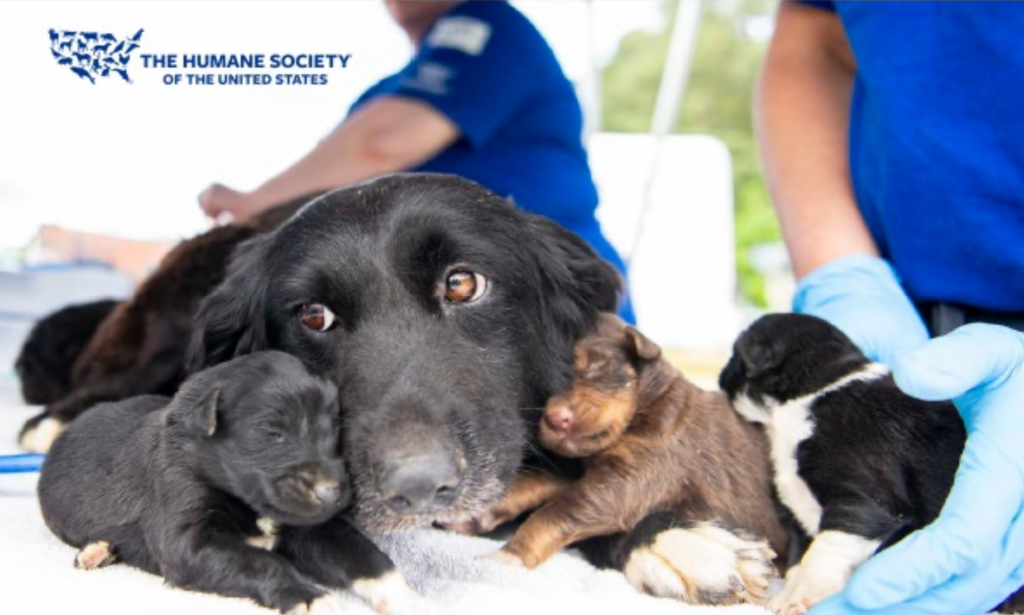September 30, 2024
Animal Rescue Team and Disaster Response
The Humane Society of the United States (HSUS) Animal Rescue Team (ART) is on call 24/7, ready to deploy whenever animals are caught in large-scale emergencies. Each year, ART rescues thousands of animals from natural and manmade catastrophes, puppy mills, animal fighting rings, hoarding situations, and other instances of cruelty and neglect.
Emergencies and natural disasters can happen without warning and are occurring more frequently. We know that almost 44% of people who did not evacuate during Hurricane Katrina kept themselves in harm’s way because of their companion animals. In the wake of Hurricane Katrina, we developed a proactive response model to better support communities facing natural catastrophes. This model is centered on clearing animal shelters ahead of storms to ensure local facilities have the space and resources to care for displaced pets. ART removes animals from immediate danger, provides on-site medical care, and transports them to safe locations where they receive the care they need until they can be permanently rehomed.
Click Here to Donate to the Emergency Animal Relief Fund!
The Critical Need
The increasing frequency of catastrophic weather events, driven by climate change, has made ART’s work more urgent than ever. Since 1980, the annual occurrence of floods and damaging rainfalls has quadrupled, and extreme weather events such as droughts, forest fires, and severe storms have doubled in the last 40 years. These disasters create dangerous conditions for animals and people alike. In the past three years alone, hundreds of thousands of animals have perished in floods, fires, and other natural disasters.
Animal Rescue Team proposaBeyond these climate-related catastrophes, cases of neglect, cruelty, abandonment, and hoarding continue to pose a serious threat to animals. While HSUS has worked tirelessly to raise public awareness and bring perpetrators of animal cruelty to justice, many areas across the U.S. still lack the resources and knowledge needed to address these issues.
Expanding and strengthening ART’s response capabilities is critical to meeting these challenges. ART is fully equipped to respond to any large-scale animal emergency, mobilizes specialized assets, such as transport vehicles and a mobile veterinary unit, and delivers shelter supplies in extreme cruelty or neglect situations.
When called upon, ART delivers a comprehensive response that includes:
- Preemptive Action: Clearing local animal shelters before a catastrophe to ensure space for displaced pets, keeping them close to their communities to facilitate family reunions.
- Rescue and Care: Removing animals from immediate peril, providing medical care on-site, and transporting them to safe locations where they receive ongoing shelter, medical treatment, and eventual placement in permanent homes.
- Technical Rescue: Our dedicated team of expert responders is certified in swift and slack water rescue. This means that in times of flooding, if animals have been left behind or their owners tried to stay but then had to leave, the team can respond to the floodwaters and safely remove them.
- Legal Support: Assisting law enforcement in investigating severe cases of animal abuse and aiding the prosecution of those responsible. ART brings significant expertise in dealing with crime scenes for animal cruelty and is the go-to source for law enforcement.
- Logistical Assistance: We deliver essential supplies, including pet food and other necessities, to shelters and families affected by disasters.
- Relief Grants: Providing financial support to local clinics and shelters for veterinary care and boarding of displaced animals.
- Emergency Planning: Collaborating with local, state, and national authorities to develop and implement disaster management plans that include animal provisions.
With the generous support of partners, we can continue to enhance ART’s ability to respond swiftly and effectively to any crises, strengthening our emergency response and rescue capabilities.
Rehabilitation and Recovery
The recovery process for rescued animals varies, with some requiring special care or long-term rehabilitation before they can be adopted. The HSUS rehabilitation facility, a 47,000- square-foot space equipped with state-of-the-art kennels, an in-house clinic, and outdoor areas, is designed to meet these needs. Here, up to 400 animals receive the care they need to recover from trauma and medical issues, ensuring they can be placed in loving homes.
Long-Term Strategy
A critical aspect of our program is working with local governments and stakeholders to integrate animals into disaster management plans. We proactively engage with high- risk communities to expand or develop disaster plans to protect the most vulnerable animals. Our commitment extends beyond immediate relief, focusing on long-term recovery and building resilience to future disasters.
Catastrophe Deployments
2017: The 2017 hurricane season required an unprecedented response. Thanks to the federal Pet Evacuation and Transportation Standards (PETS) Act, passed in Katrina’s wake at the urging of the HSUS, there were more resources to keep pets and families together, but the needs were still massive here and abroad. ART assisted in Texas, Florida, and Puerto Rico. After the storms, we provided search and rescue capacity, wildlife expertise, and support to pet owners in impacted communities. We assisted over 15,000 animals and provided thousands of pounds of human and animal supplies.
Hurricane Harvey – Texas: We evacuated 1,007 adoptable animals from Texas, which freed up space in local shelters for the influx of displaced and lost animals who arrived in the storm’s wake. We conducted 16 transports out of Texas by air and ground to partners nationwide. We coordinated the delivery of 8 tons of feed, 1,500 bags of shavings, and 2,554 hay bales to the Delta Equine Center in Galveston. After the storm, we worked with local officials to conduct search and rescue operations, helping local authorities recover 138 animals stranded in homes. ART also conducted an aerial assessment of stranded cattle in Southeast Texas, providing their coordinates to the Texas Air National Guard, who could drop hay to feed the cattle until the water receded. Expense: $1,516,863
Hurricane Irma—Florida: We transported more than 900 adoptable animals out of harm’s way and provided 10,000 pounds of donations to shelters and human service agencies in impacted areas as the storm approached. Our own South Florida Wildlife Center was caught in the crosshairs of Irma; it sustained significant damage and lost power for days. But that didn’t stop our staff from opening the day after the storm and taking in more than 400 injured wildlife while simultaneously working on repairs. Many of the animals taken in were injured and young orphaned, and they had been blown from nests. Expense: $316,193
Hurricane Maria – Puerto Rico: Through our Humane Puerto Rico program, the HSUS has close relationships with animal welfare organizations on the island. With the cooperation of the Puerto Rican government, we launched a transport to evacuate 2,000 adoptable dogs and cats, placing them through our networks with help from St. Hubert’s Animal Welfare Center. With help from the South Florida Wildlife Center, we organized dozens of relief flights and shipments, delivering 300,000 pounds of human and animal supplies to hard-hit neighborhoods on mainland Puerto Rico and the island of Vieques. Expense: $3,469,170
2018: When two major Atlantic hurricanes landed a one-two punch on the Southeast U.S., ART deployed, saving animals before, during, and after Hurricanes Florence and Michael. We coordinated and funded transports of hundreds of animals from area shelters and deployed to some of the hardest-hit areas to help stranded and abandoned animals, organize food deliveries, carry out field rescues, and help storm-damaged shelters recover. All told, we directly helped more than 650 animals and transported more than 1,000 to safety. Expense: $394,728
2020: ART was deployed several times for extreme natural disasters, and nearly 600 animals were transported out of shelters to provide space for incoming animals affected by storms. After Hurricane Sally walloped Florida, we helped in Escambia County by delivering food and supplies to impacted shelters and transporting animals for veterinary care in storm-hit communities. Expense: $61,397
2021: ART deployed to Kentucky to assist the Mayfield-Graves County animal shelter with search and rescue and shelter operations after devastating tornadoes. We remained on the scene to help reunite lost pets with their families, distribute resources to pet owners, and transport surrendered animals to shelter partners for adoption. Expense: $45,766
2022: Before Hurricane Ian, the HSUS funded and facilitated the safe transport of more than 150 adoptable dogs, cats, and guinea pigs from Florida shelters to our shelter partners, freeing capacity for lost animals after the storm. In the weeks following the storm, we ran a pet food/supplies distribution center and a pop-up veterinary clinic offering free vet services in Port Charlotte, Florida. Expense: $203,209
2023: In Florida, we transported dozens of shelter animals out of the path of Hurricane Idalia and distributed free pet food and farm animal feed in the aftermath, reaching 872 families and 9,083 animals. Expense: $114,770
In Maui, after the devastating wildfires, we sent urgent and critical supplies such as pet food and crates to the Maui Humane Society and helped staff process the influx of reports about lost and found pets.
ART has rescued over 55,000 animals from cruelty and catastrophes. In 2024 alone, ART already has four non-catastrophe deployments, assisting law enforcement in rescuing 1,217 animals.
- 55,000+ Animals recieved care from our animal rescue team after being saved from cruetly and disasters
- 350+ Shelters Animal across the country allow us to call on them when rescued animals need a safe place to go; they are known as our Shelter and Rescue Partners.
- 30,000+ Hours are spent annually by animal rescue volunteers.
Critical Enhancements for Immediate Action
Our Animal Rescue Team’s disaster work extends far beyond boots-on-the-ground response. We work year-round with communities across the U.S. to prepare for increasingly severe storm seasons. For instance, last November, we partnered with the Virginia Federation of Humane Societies to safeguard shelter animals during storms. We also collaborate with local
governments and partners to incorporate animal welfare into their disaster preparedness plans, providing essential training and helping develop robust protocols. Recently, the HSUS hosted disaster preparedness training for 21 law enforcement officers in Indiana.
When disasters strike, our support doesn’t end with immediate relief. After Tropical Storm Debby caused severe flooding and power outages in the Southeastern U.S., we provided critical supplies and funding to the affected counties. Our work continues long after the initial crisis, offering long-term support to help animal caretakers and communities recover and build stronger resilience for the future.
Our team depends on specialized equipment to access remote areas and perform reliably in extreme weather conditions. As we continue to provide essential support and help communities recover after disasters, we must enhance our operational capabilities to serve those in need better. To achieve this, we have identified several capital improvements that will significantly strengthen our response efforts.
Immediate Needs for Enhanced Rescue Readiness:
- Dodgen Mobile Technology Specialty Vehicle – Replace our aging 2012 Dodgen catastrophe response vehicle, which has experienced multiple breakdowns during recent deployments, to ensure we are equipped for rapid and reliable response in future disasters. ($175,000)
- Mobile X-ray Unit – Improve medical and diagnostic capabilities, reducing dependency on external clinics and ensuring faster, more cost- effective treatment for rescued animals. ($85,000)
- Transit Sprinter Van – Enable efficient regional transport of animals, including airport runs and emergency deployments, reducing reliance on Penske vehicles. ($80,000)
- Facility Improvements – Install Karunda dog beds and add a new roof over exercise patio, allowing for year-round, all-weather use to improve animal comfort and rehabilitation conditions. Purchase four “evapfans” to better regulate temperature in the rehabilitation center, ensuring a stable and comfortable environment for animals recovering from crises. ($75,000)
We invite you to partner with us in this critical, lifesaving mission. Our rescue team’s readiness and success depend on the continued support of compassionate individuals and organizations like yours.
By working together, we can dramatically increase our ability to save animals from life-threatening situations, and we are eager to explore impactful ways to collaborate on catastrophe response.
| Budget Animal Rescue Team – U.S. | 2025 |
| Salaries & Benefits | $2,703,000 |
| Travel | $907,500 |
| Consultants & Services | $2,137,500 |
| Animal Care & Vet Supplies | $364,500 |
| Workshops & Symposiums | $30,000 |
| Operations, including communications, public relations, evaluation, administrative support, and accounting. | $307,125 |
| Total 2025 Budget | $6,449,625 |
Our Mission
The Humane Society of the United States aims to create a better world for all animals. The Humane Society family of organizations works around the globe to protect companion animals and wildlife, improve farm animal welfare, promote animal-free testing methods, and reform industries that harm animals. Through our rescue, response, sanctuary work, and other direct services, we help thousands of animals in need. We also work to end the cruelest practices toward animals, care for animals in crisis, and build a more robust animal protection movement worldwide.
Contact:
Steve McVeigh: Vice President Business Development, 301-548-7730, smcveigh@humanesociety.org
Erin Jackson: Senior Foundation Relations Manager, 717-715-4012, ejackson@humanesociety.org

Get Resources and Insights Straight To Your Inbox
Explore More Articles
Workplace Fundraising + Volunteering Summit (April 2nd and 3rd, 2025)
Join us in attending this virtual summit! The America’s Charities team is joining up with other leading voices in the workplace giving space for a…
Read ArticleThe Time to Act is Now
The results of the 2024 National Assessment of Educational Progress (NAEP) are in, and the findings are, in a word, heartbreaking. This assessment serves as…
Read ArticleOpen Position: Non-Profit Account Manager, Employee Assistance Funds & Scholarships (Remote – Full Time)
We are professional, agile, customer-centric and our goal is to inspire employees and organizations to support causes they care about. We help nonprofits fundraise unrestricted,…
Read ArticleGet Resources and Insights Straight To Your Inbox
Receive our monthly/bi-monthly newsletter filled with information about causes, nonprofit impact, and topics important for corporate social responsibility and employee engagement professionals, including disaster response, workplace giving, matching gifts, employee assistance funds, volunteering, scholarship award program management, grantmaking, and other philanthropic initiatives.




